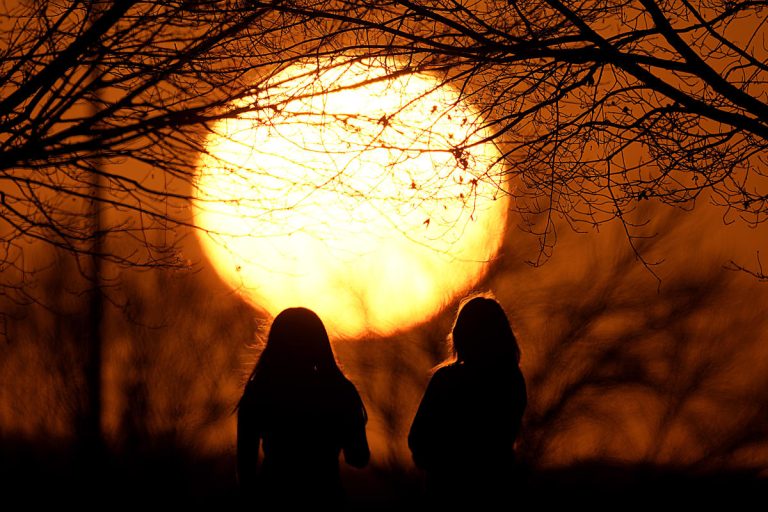BOSTON (AP) — A powerful winter storm began dumping up to several feet of snow at higher elevations in the West on Monday while much of the central United States was basking in unseasonably warm conditions — at least for a few days. Stormy conditions increased the possibility of fires in several states.
The National Weather Service warned that travel could be dangerous later Monday across parts of the Oregon Cascades and Northern Rockies, forecasting near-blizzard conditions with an inch or two of snow falling per hour and winds of up to 65 mph (104 km). / hour).
The storm will move into the Great Basin and central Rocky Mountains on Tuesday, bringing with it cooler temperatures and strong winds across the mountain western interior, said Andrew Orrison, a meteorologist with the National Weather Service in College Park, Maryland.
“It's going to be very wintry for the next couple of days,” he added.
The West is just one place experiencing unusual and, in some cases, dangerous weather conditions. Here's what to expect elsewhere.
It's warm in the Heartland
This time of year must be the coldest in places like Chicago. But the city and many others across the central United States are getting an early taste of summer with temperatures in the 60s to 70s.
Warm conditions have persisted since mild weekend temperatures reached the 60s in Denver, Chicago and Des Moines, Iowa. Kansas City, Missouri, enjoyed temperatures in the mid-70s.
In Chicago, the temperature is expected to reach 67 degrees (19 C) on Monday, breaking Chicago's old record of 64 degrees (18 C). Wind speeds are expected to reach 25 mph (40 km/h). Highs on Tuesday are expected to reach the mid-70s, challenging Chicago's record of 75 (24 degrees Celsius) for the date.
Highs on Monday are expected to reach the mid-60s across southern Wisconsin and extend north to Rhinelander, a city of 8,000 located just below Michigan's Upper Peninsula.
“We're breaking records from northern Illinois to south-central and southwestern Wisconsin,” said Mark Gehring, a meteorologist with the Weather Service in Sullivan, Wisconsin.
The local weather service office said Monday's warm temperatures “will ensure” that the frigid Minneapolis area will experience its warmest winter on record. While Monday's expected high is 63 (17°C) in Minneapolis-St. Paul International Airport will be one degree lower than the record set in 1896, and the temperature in St. Cloud in central Minnesota was expected to reach 59 (15 degrees Celsius), breaking the old record of 55 (13 degrees Celsius) set in 1958.
But it's not time to stock up on scarves and gloves until next winter.
Places like Chicago will see a significant drop in temperatures by Wednesday, with highs just below freezing and wind gusts of up to 30 mph (48 kph). Cold weather Tuesday and Wednesday could bring an inch or two of slush snow that could freeze and make for a dangerous trip Wednesday morning, the Minnesota Weather Service said.
Golf, in Wisconsin, in February?
Weeks of unseasonably warm weather prompted Jessica Blaska Grady, general manager of Oaks Golf Course in Sun Prairie Township east of Madison, to reopen for the season on Feb. 9. She said she can only remember one other winter — 2017 — when the course was open in February.
“It's definitely kind of crazy,” she said. “This is incredibly unusual but I'm not going to lie and say it's not welcome. It's a nice little boost. You have to make hay when the sun comes up.”
Lori Cervantes, 53, doesn't remember a winter like this in the 20 years she's lived in Iowa. She returned eight months ago after living in Portland, Oregon. “This weather is so nice,” she said.
She took her dog, Gus, for a daily walk in the “unprecedented” weather and meditated in the sunshine outside the gold-domed Iowa State Capitol in Des Moines.
“It's actually a little scary,” she said, noting that flower bulbs were already emerging from the ground, and wondered how this would impact farmers and fields this growing season. “It's an early way to be warm and dry.”
Gehring attributed the unusual warmth to an El Niño pattern, a term that refers to a warming of the tropical Pacific Ocean that pushes the jet stream northward. These bands of strong winds form a boundary between the cold northern air and the warm southern air. Gering also noted that climate change has played a role in rising temperatures for decades.
Warmer conditions in many parts of the country have led to the cancellation of winter events such as ski races and hockey tournaments. The most recent cancellation was the longest sled dog race in the eastern United States.
Fire danger in the plains
But warmer temperatures have increased fire danger across the Great Plains.
The National Weather Service said dry, gusty winds were causing what it described as critical fire weather conditions, and it issued red flag warnings and fire weather watches in parts of New Mexico, Colorado, Texas, Oklahoma and even Kansas, Nebraska, South Dakota and Washington. East to Iowa, Illinois and Missouri.
Nearby states, including parts of Arkansas, Minnesota and Wisconsin, were under dangerous weather forecasts due to increased fire danger, according to weather service maps. On Monday morning, the Wisconsin Department of Natural Resources issued a do not burn anything outdoor advisory, noting that 15 wildfires burned over the weekend, burning more than 30 acres.
____
Associated Press writers Todd Richmond in Madison, Wisconsin, and Hannah Fingerhut in Des Moines, Iowa, contributed to this report.

